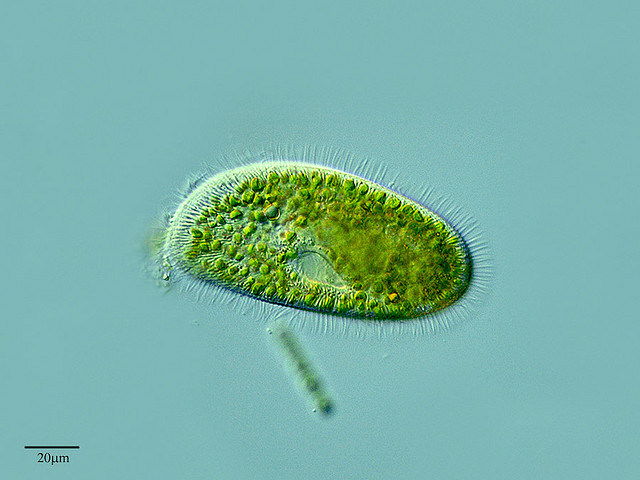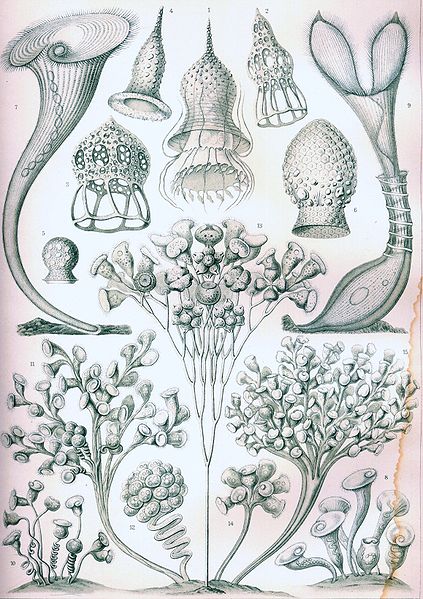The games in this video could be used to teach about biology, according to the folks at New Scientist. Or about behaving as a merciless puppetmaster/God to a bunch of innocent protists. Your choice.
I’m torn here. On the one hand, this is really cool. On the other, it somehow feels horribly wrong. I mean I’m sure it’s not much more wrong than what I do to baker’s yeast every time I bake bread. But . . . I don’t toy with the yeast before I incinerate them. Yeesh.
Anywho, for those who are unfamiliar, paramecia are classic organisms used to teach high school and college students about microbes. But they’re not simply boring microbial lab rats. They’re fascinatingly formed, filled, and operated little creatures. They are often described as “slipper-shaped”, or, as van Leeuwenhoek would have it, “slipper animalcules”. In this video, watch for the little cilia beating all over the cell’s pellicle, or membrane+submembrane shell.
So let’s have a tribute to the humble Paramecium today — we’ll take a closer look at a microbe you might think you already know. Think again. Take a look at the basic paramecium formula here (I can’t post it because I don’t have copyright). I’ll refer to the various parts of this diagram as we go along.
Paramecia are ciliates, protists coated in little beating hairs called cilia for at least part of their life cycle. In photographs where only their cilia are stained or photographed with scanning electron microscopy, paramecia look like ovoid shag rugs (or see here or here). These cilia can beat in forward or reverse with extreme precision — much more precise than large flagellae or lumbering pseudopods. When beating in foward or reverse, the paramecium moves in a spiral motion around an invisible axis — and they can throw it into reverse in a ciliumbeat to avoid obstacles or “negative stimuli” (cough).
Inside the cell is a contractile vacuole used to bail out water against the perpetual osmotic gradient (the inside of the cell has a higher solute concentration than its watery surroundings, leading water to constantly seep through the membrane by osmosis, like a leaky ship), various vacuoles (spherical storage vessels) for digesting food and excreting waste, and at least one micronucleus and macronucleus.
The micronucleus, of which there may be as few as one or as many as 80, is diploid, or contains two copies of all the DNA, just like all of your cells. But the macronucleus may contain 50-500 times as much DNA as the micronucleus (the Paramecium aurelia macronucleus is 860-ploid, according to one of my biology texts). The micronucleus is all about passing DNA to mating partners for sexual reproduction (aka swapping genes), while the macronucleus is in the business of pumping out messenger RNA and getting it translated into proteins.If you remove the micronucleus, the cell can divide asexually another 350 or so times before dying of no sex (yes, in ciliates, this can apparently happen). But if you remove the macronucleus, the cell immediately dies.
On the surface of the cell is a funnel-shaped oral groove that guides food particles toward a pocket where food vacuoles are created. Enzymes get pumped inside to digest whatever hapless bacteria, yeast or “other” finds its way inside. Many paramecia may contain symbiotic bacteria living within them or even within their macronucleus, perhaps providing vitamins or other growth factors that would otherwise be hard to get. One paramecium even has photosynthetic symbionts. Paramecium bursaria, which has ingested and partnered with the green alga Zoochlorella.
These are *not* chloroplasts, or rather, they are not homologous to (share a common ancestry with) the chloroplasts in plants. Plant chloroplasts are ingested cyanobacteria. Zoochlorella are chloroplasts in the sense that they are internal photosynthetic symbionts, but they were free-living eukaryotic (nucleated — not bacterial) algae before ingestion. But here’s the mind-twister: the chloroplasts within the Zoochlorella are homologous to plant chloroplasts, because plants evolved from green algae.
This is the only Paramecium known to do this. To what extent the Zoochlorella could pop out of that paramecium and get along on its own or is degenerate and helpless I do not know.

Paramecium bursaria, a rare symbiotic photosynthetic paramecium. Love the gorgeous detail. Creative Commons PROYECTO AGUA**/**WATER PROJECT
Some large ciliates may hold the land-speed record for all protists. They can cruise at a blinding 2 millimeters per second, which, assuming a 250-micrometer paramecium and a 5.5-foot human [calculator tapping noises], is the equivalent our 5.5-foot human swimming a blazing 30 miles per hour*. And they are backstroking at these speeds through a medium that has the viscosity (to a proist) of molasses.(See the middle of Psi Wavefunction’s post here, or for the physics-buff bionerds out there, the original 1977 paper “Life at [a] Low Reynolds Number” here).
Paramecia are also armored with a built-in defense system. Their pellicle is laced with dart-tipped harpoon-esque “trichocysts” (a specific type of a more general organelle called an “extrusome“, which is clearly another case of convergence (independent invention of the same structure) with jellyfish nematocsyts), which deploy explosively within milliseconds if the paramecium feels threatened, is feeling peckish, or perhaps needs a convenient anchor while it tucks in to dinner. See how they look retracted here, and how they look once fully-expelled here, which this site describes as the “disheveled porcupine” look. The bottom photo is of undeployed trichocysts in the pellicle**.
Paramecia are, as mentioned, ciliates. There are something like 9,000 species in fresh and salt water, and their complexity and diversity of form is astounding. Some of the most complex species come close to replicating the digestive systems, muscles, exoskeletal systems and even vertebrae so characteristic of multicellular life within a single cell. According to one of my biology texts, ciliates have produced the greatest specialization of subcellular organelles of any protist. Rest assured you will read more about the creatures in this group at this blog.
Ciliates fit into the larger taxon (group) called alveolates, a term you may recognize from high school biology as the name for the little sacs at the ends of the passages of your lungs. The structures are similar; the Latin just means “little cavities”, and in ciliates like Paramecium they are little membranous sacs found just below the cell surface engulfing the roots of cilia. Though the ciliates like Paramecium and the dinoflagellates and parasitic apicomplexans may seem worlds apart, they all share this feature and several others*** that reveal their common ancestry. See how the ciliates fit into the alveolates, and how the alvaeolates fit into the eukaryotes here and here.
Before I leave you today (or is it the other way around?), enjoy this video of some more active paramecia tooling around with a bunch of nerdy Euglena (the little guys). Because before you allow your little microbial minions to be devoured by Pac-Mecium or taunt them with a chemical blast, remember: were they your size (or you theirs), you’d never survive the hairpin extrusome assault mechanism, and they’d be gone before you knew what hit you. : )
________________________________________________
*or 48 km/hr for you metric users. According to the intertubes, the fastest human swimmers can go is around 5 miles/hr over very short distances. Of course, their bodies are not covered in highly-efficient propulsive cilia (and more’s the pity).
**With all this weaponry, forget Pac-mecium. Helloooooo Ultimate Paramecium Fighting League.
***including, for the bionerds out there, tubular mitochondrial christae, “closed mitosis” in which the micronuclear membrane doesn’t dissolve during mitosis and the mitotic spindle forms inside it, and similar “extrusive organs” like trichocysts



{ 1 trackback }
{ 6 comments… read them below or add one }
Hey Jennifer,
First let me say I only recently started following your blog, and really enjoy it. Excellent work.
I had a question about Zoochlorella chloroplasts. I knew algae acquired chloroplasts differently than plants (instead of engulfing cyanobacteria like plants, they engulfed other photosynthetic eukaryotes), but have never learned how the engulfed eurkaryote’s chloroplasts were acquired. I guess I’m asking if algal chloroplasts are still cyanobacteria-derived, just acquired by eating something that already ate the cyanobacteria? Hmm… reminds me of Russian nesting dolls.
The Russian dolls scenario can and definitely has happened. Botanists have found chloroplasts with nested membranes that indicate there were two or three or perhaps even more sequential separate endysymbiotic events, aka, getting eaten but not digested and going on to be a symbiont of a symbiont of a symbiont. . . . sometimes even vestigial nuclei are squashed between the membranes, but little else. And you are right — green algae are the group from which plants evolved. So the chloroplasts *within* the green alga are, in fact, cyanobacterially derived. I’m going to amend the post to reflect that fact — I hadn’t even thought of it myself. : )
Those games are horrible! It doesn’t matter if they’re single-celled — you do NOT torment animals for your own amusement!
That’s a bit twisted I think. “Don’t play with your food”
This is further along the road to skynet: http://www.robotliving.com/robot-art/robotic-fly-powered-clock/
Jen, this post is funny, beautifully written, and totally fascinating. All those cool words from high school biology are trickling back into my consciousness! Your blog is a must-read.
Just wanted to say that this blog is very informative, and is actually fun and interesting to read through. I needed to look up some info for a project and ended up reading more than just this post! Thanks for making things interesting, this blog is very well written :)